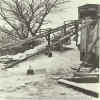| The next step was getting the ice blocks into the icehouse. The majority of the ice
broken from the float weighed anywhere from 250 to 300 pounds, which made it difficult for
men to carry. To avoid this problem, power-driven elevators were used to carry the blocks
to the icehouse. These elevators were made of steel links with steel bars properly spaced
to carry one block of ice. The blocks went through "shavers" to mold the
blocks to the correct size and specifications. The shavers had sharp, chisel-like steel
teeth that shaved off the excess ice. |
 |
Conveyer |
|


![]()
![]()